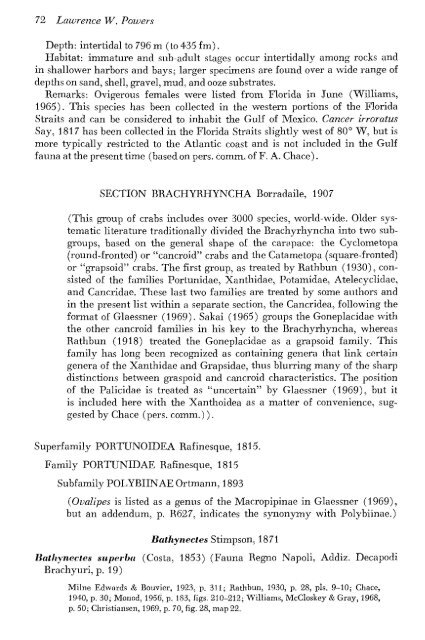Create successful ePaper yourself
Turn your PDF publications into a flip-book with our unique Google optimized e-Paper software.
72 Lawrence W. Powers<br />
Depth: intertidal to 796 m (to 435 fm).<br />
Habitat: immature and sub-adult stages occur intertidally among rocks and<br />
in shallower harbors and bays; larger specimens are found over a wide range of<br />
depths on sand, shell, gravel, mud, and ooze substrates.<br />
Remarks: Ovigerous females were listed from Florida in June (William^s,<br />
1965). This species has been collected in the western portions of the Florida<br />
Straits and can be considered to inhabit the Gulf of Mexico. Cancer irroratus<br />
Say, 1817 has been collected in the Florida Straits slightly west of 80° W, but is<br />
more typically restricted to the Atlantic coast and is not included in the Gulf<br />
fauna at the present time (based on pers. comm. of F. A. Chace).<br />
SECTION BRACHYRHYNCHA Borradaile, 1907<br />
(This group of crabs includes over 3000 species, world-wide. Older systematic<br />
literature traditionall}'^ divided the Brachyrhyncha into two subgroups,<br />
based on the general shape of the carapace: the Cyclometopa<br />
(round-fronted) or "cancroid" crabs and the Catametopa (square-fronted)<br />
or "grapsoid" crabs. The first group, as treated by Rathbun (1930), consisted<br />
of the families Portunidae, Xanthidae, Potamidae, Atelecyclidae,<br />
and Cancridae. These last two families are treated by some authors and<br />
in the present list within a separate section, the Cancridea, following the<br />
format of Glaessner (1969). Sakai (1965) groups the Goneplacidae with<br />
the other cancroid families in his key to the Brachyrhyncha, whereas<br />
Rathbun (1918) treated the Goneplacidae as a grapsoid family. This<br />
family has long been recognized as containing genera that link certain<br />
genera of the Xanthidae and Grapsidae, thus blurring many of the sharp<br />
distinctions between graspoid and cancroid characteristics. The position<br />
of the Palicidae is treated as "uncertain" by Glaessner (1969), but it<br />
is included here with the Xanthoidea as a matter of convenience, suggested<br />
by Chace (pers. comm.)).<br />
Superfamily PORTUNOIDEA Rafinesque, 1815.<br />
Family PORTUNIDAE Rafinesque, 1815<br />
Subfamily POLYBIINAE Ortmann, 1893<br />
(Ovalipes is listed as a genus of the Macropipinae in Glaessner (1969),<br />
but an addendum, p. R627, indicates the synonymy with Polybiinae.)<br />
Balhynecles Stimpson, 1871<br />
Balhynecies superba (Costa, 1853) (Fauna Regno Napoli, Addiz. Decapodi<br />
Brachyuri, p. 19)<br />
Milne Edwards & Bouvier, 1923, p. 311; Rathbun, 1930, p. 28, pis. 9-10; Chace,<br />
1940, p. 30; Monod, 1956, p. 183, figs. 210-212; Williams, McCIoskey & Gray, 1968,<br />
p. 50; Christiansen, 1969, p. 70, fig. 28, map 22.

















